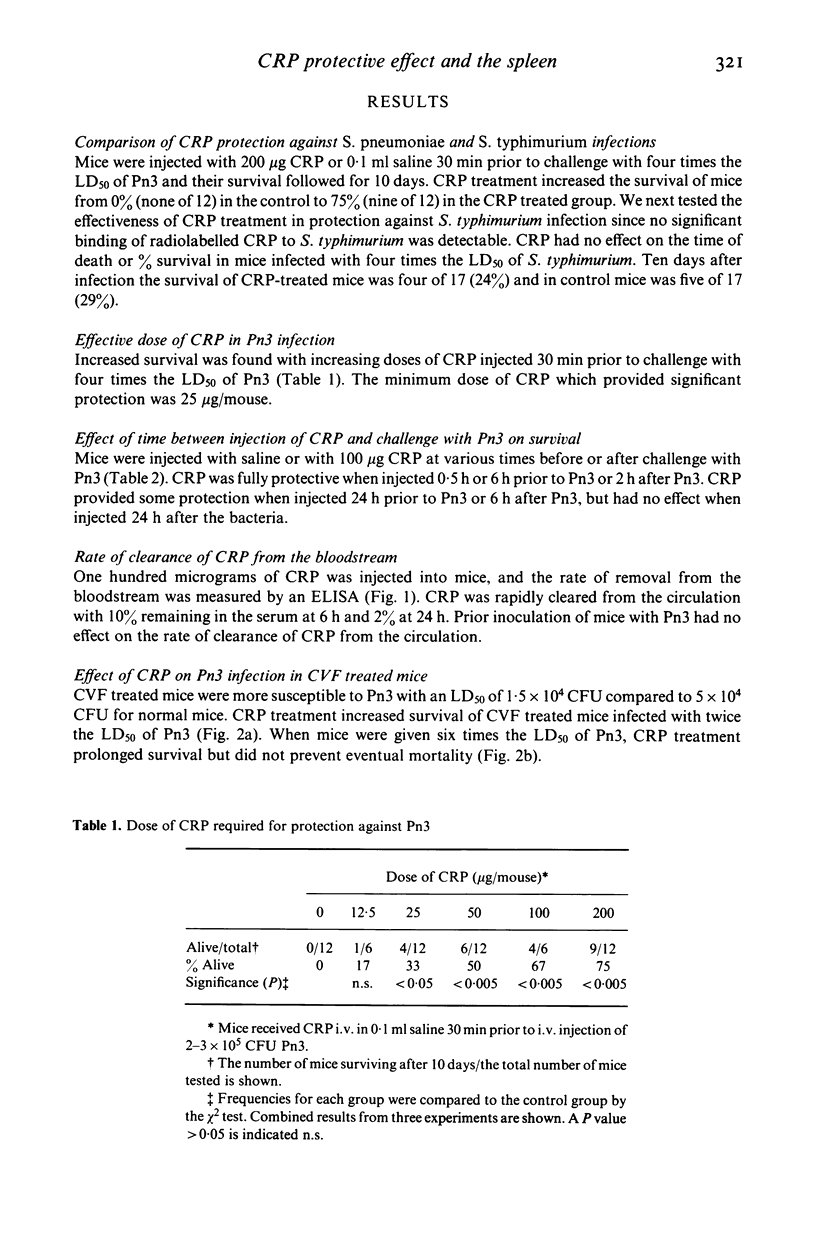Abstract
C-reactive protein (CRP) is an acute phase serum protein in man which activates complement and has opsonic activity. We have reported that prior injection of CRP into mice can increase their survival following intravenous challenge with Streptococcus pneumoniae type 3 or 4. In this study the conditions required for protection, and the role of hepatic and splenic clearance of bacteria have been examined. Protection against lethal infection was observed with a minimum dose of 25-50 micrograms CRP per mouse. CRP was most effective when administered between 6 h before and 2 h after challenge. CRP treated mice were not protected against infection with Salmonella typhimurium, LT-2, an organism which does not bind CRP. Mice depleted of C3 by treatment with cobra venom factor were protected against S. pneumoniae infection by CRP. Pre-treatment of mice with CRP did not increase the rate of clearance of viable S. pneumoniae from the bloodstream but did increase splenic and decrease hepatic clearance of radiolabelled bacteria in both normal and complement depleted mice. Although these findings suggest a role for the spleen in CRP protection, mice which had been splenectomized were also protected against lethal pneumococcal infection by CRP treatment.
Full text
PDF







Selected References
These references are in PubMed. This may not be the complete list of references from this article.
- Bisno A. L., Freeman J. C. The syndrome of asplenia, pneumococcal sepsis, and disseminated intravascular coagulation. Ann Intern Med. 1970 Mar;72(3):389–393. doi: 10.7326/0003-4819-72-3-389. [DOI] [PubMed] [Google Scholar]
- Briles D. E., Claflin J. L., Schroer K., Forman C. Mouse Igg3 antibodies are highly protective against infection with Streptococcus pneumoniae. Nature. 1981 Nov 5;294(5836):88–90. doi: 10.1038/294088a0. [DOI] [PubMed] [Google Scholar]
- Briles D. E., Nahm M., Schroer K., Davie J., Baker P., Kearney J., Barletta R. Antiphosphocholine antibodies found in normal mouse serum are protective against intravenous infection with type 3 streptococcus pneumoniae. J Exp Med. 1981 Mar 1;153(3):694–705. doi: 10.1084/jem.153.3.694. [DOI] [PMC free article] [PubMed] [Google Scholar]
- Brown E. J., Hosea S. W., Frank M. M. The role of the spleen in experimental pneumococcal bacteremia. J Clin Invest. 1981 Apr;67(4):975–982. doi: 10.1172/JCI110148. [DOI] [PMC free article] [PubMed] [Google Scholar]
- Claus D. R., Osmand A. P., Gewurz H. Radioimmunoassay of human C-reactive protein and levels in normal sera. J Lab Clin Med. 1976 Jan;87(1):120–128. [PubMed] [Google Scholar]
- Edwards K. M., Gewurz H., Lint T. F., Mold C. A role for C-reactive protein in the complement-mediated stimulation of human neutrophils by type 27 Streptococcus pneumoniae. J Immunol. 1982 Jun;128(6):2493–2496. [PubMed] [Google Scholar]
- Gewurz H., Mold C., Siegel J., Fiedel B. C-reactive protein and the acute phase response. Adv Intern Med. 1982;27:345–372. [PubMed] [Google Scholar]
- HOKAMA Y., COLEMAN M. K., RILEY R. F. In vitro effects of C-reactive protein on phagocytosis. J Bacteriol. 1962 May;83:1017–1024. doi: 10.1128/jb.83.5.1017-1024.1962. [DOI] [PMC free article] [PubMed] [Google Scholar]
- Kindmark C. O. Stimulating effect of C-reactive protein on phagocytosis of various species of pathogenic bacteria. Clin Exp Immunol. 1971 Jun;8(6):941–948. [PMC free article] [PubMed] [Google Scholar]
- Mold C., Edwards K. M., Gewurz H. Effect of C-reactive protein on the complement-mediated stimulated of human neutrophils by Streptococcus pneumoniae serotypes 3 and 6. Infect Immun. 1982 Sep;37(3):987–992. doi: 10.1128/iai.37.3.987-992.1982. [DOI] [PMC free article] [PubMed] [Google Scholar]
- Mold C., Nakayama S., Holzer T. J., Gewurz H., Du Clos T. W. C-reactive protein is protective against Streptococcus pneumoniae infection in mice. J Exp Med. 1981 Nov 1;154(5):1703–1708. doi: 10.1084/jem.154.5.1703. [DOI] [PMC free article] [PubMed] [Google Scholar]
- Mortensen R. F., Duszkiewicz J. A. Mediation of CRP-dependent phagocytosis through mouse macrophage Fc-receptors. J Immunol. 1977 Nov;119(5):1611–1616. [PubMed] [Google Scholar]
- Mortensen R. F., Osmand A. P., Lint T. F., Gewurz H. Interaction of C-reactive protein with lymphocytes and monocytes: complement-dependent adherence and phagocytosis. J Immunol. 1976 Sep;117(3):774–781. [PubMed] [Google Scholar]
- Nakayama S., Mold C., Gewurz H., du Clos T. W. Opsonic properties of C-reactive protein in vivo. J Immunol. 1982 Jun;128(6):2435–2438. [PubMed] [Google Scholar]
- Schulkind M. L., Ellis E. F., Smith R. T. Effect of antibody upon clearance of I-125-labelled pneumococci by the spleen and liver. Pediatr Res. 1967 May;1(3):178–184. doi: 10.1203/00006450-196705000-00004. [DOI] [PubMed] [Google Scholar]
- Shinefield H. R., Steinberg C. R., Kaye D. Effect of splenectomy on the susceptibility of mice inoculated with Diplococcus pneumoniae. J Exp Med. 1966 May 1;123(5):777–794. doi: 10.1084/jem.123.5.777. [DOI] [PMC free article] [PubMed] [Google Scholar]
- Waldmann T. A., Strober W. Metabolism of immunoglobulins. Prog Allergy. 1969;13:1–110. doi: 10.1159/000385919. [DOI] [PubMed] [Google Scholar]
- Whitaker A. N. The effect of previous splenectomy on the course of pneumococcal bacteriaemia in mice. J Pathol Bacteriol. 1968 Apr;95(2):357–376. doi: 10.1002/path.1700950203. [DOI] [PubMed] [Google Scholar]
- Williams R. C., Jr, Quie P. G. Studies of human C-reactive protein in an in vitro phagocytic system. J Immunol. 1968 Sep;101(3):426–432. [PubMed] [Google Scholar]
- Yother J., Volanakis J. E., Briles D. E. Human C-reactive protein is protective against fatal Streptococcus pneumoniae infection in mice. J Immunol. 1982 May;128(5):2374–2376. [PubMed] [Google Scholar]


